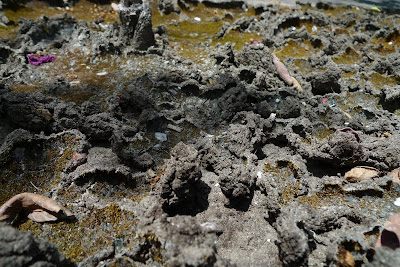Been a while since I "blogged" in here. What am I doing these days? Mostly working on these enigmatic Sierran garnet-bearing meta-quartzite xenoliths. Yup, garnet-bearing quartzites - sounds weird, and it is! Why am I even looking at such oddities? Well, we think these rocks are evidence of crustal thickening that occurred while the Sierra Nevada batholith was being built by magmatism. Textural and mineralogical evidence (>60% modal quartz, abundant well-rounded detrital zircons) points to a supracrustal origin, but hi TitaniQ temperatures (~750-800 C) and metamorphic garnet (~50Py50Alm) suggest increasing P,T may have occurred - emplacing these sed rocks deep into the mid to lower crust! The story deepens further... We blasted several of the detrital zircons to obtain U-Pb and Hf isotopes simultaneously on the same spot. The set-up was pretty cool, involving 2 mass spectrometers (an ELEMENT XR and a Neptune), and one laser beam split to enter each instrument. U-Pb results show that the detrital zircons are rather unruly, all plotting on discordia. Upper intercept ages are all ancient, indicating provenance from old North American basement terrains. However, all the zircons have similar lower intercept ages, clustering around ~100 Ma - which, as you all know, is the time of peak magmatism in the Sierras. But wait! The trail of clues continues... modeling with THERIAK DOMINO for a given Sierran metaquartzite composition shows that garnet and feldspar are stable between approx 6 kbar to 15 kbar. That is considerably deeper than the maximum thickness estimated for the western Cordilleran miogeocline, which is 3.3 kbar (10 km). (The likeliest protoliths for the metaquartzites are miogeoclinal sediments. Many of these are exposed throughout the batholith - in the form of roof pendants.) Thus, if these xenoliths are indeed originally strata of the miogeocline, what the heck are they doing sitting at >6 kbar? Well... one hypothesis involves magmatic inflation, which can thicken the crust as successive sills are emplaced. Rocks below the level of neutral buoyancy where the plutons rise and stall within the crust will experience an increase in pressure. Perhaps these xenoliths represent such strata. Another idea is that a mega continental underthrust rapidly emplaced a large amount of crust from the east. Yet another idea involves a cryptic mega-strike slip fault that displaced large blocks of the miogeocline northwestward in the early Cretaceous... I find this last hypothesis difficult to test, but the other two and especially the first are interesting.
This project has definitely taken me into a different direction than my main one, which deals primarily with the mantle petrology of continental arcs. I've been learning much more about metamorphic petrology, which I had almost none of during my undergraduate courses (we took petrology in an abbreviated, intense "lagniappe" summer semester after Hurricane Katrina, where we met for 4 days 2 hours a day for 6 weeks... and metamorphic petrology just got squeezed in at the very end). Metapelitic systems are definitely complicated, with many minerals and reactions going on. I am trying my best to "see the forest for the trees" and not get mired down in tiny details.
On another note... here's a picture of some extreme biologically-mediated mudcracking behavior I observed last August, right here in my home parking lot:


I observed this little patch of dirt suffering so and peeling under the heat of the Houston sun in August. It hadn't rained for several days... I wonder how far these things could've peeled up if it hadn't rained.

